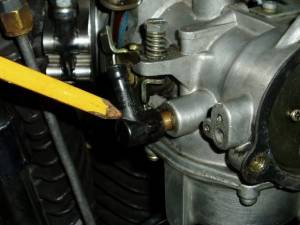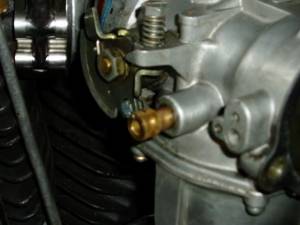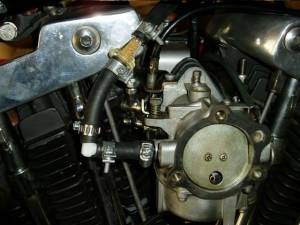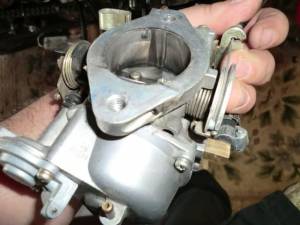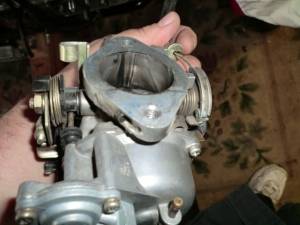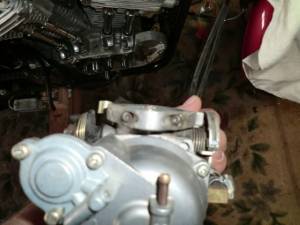Table of Contents
This is an old revision of the document!
IH: Carburetor, Intake Manifold & Exhaust - Sub-01Q
Rebuilding the Keihin Butterfly Carb
See also in the Sportsterpedia.
Disassembly
- Removing the carb from the bike should be straight forward. First thing when it is out is to check the pilot screw setting. 1)
Turn it all the way in until gently seated counting the number of 1/4 turns; then write this number down; then reset it.
This rig works well to get the carb off to fit the heat block without having to take off the horn and ignition switch brackets.
1/2“ deep socket, 3/8” drive, universal joint and 6“ extension.
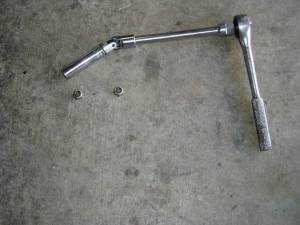 2)
2)
- Pilot screw:
- Remove the pilot screw and clean the parts and the passage.
- The passage contains in this sequence: (pilot screw, spring, washer, O-ring).
- These are very small parts, especially the washer and O-ring. Usually the spring will easily fall out.
- The technique for removing the washer and O-ring is usually to use a pipe cleaner:
Stick it in the hole, twist it around, remove it - you should see the washer and O-ring on the end of the pipe cleaner.
Remember that the purpose of the washer is to protect the O-ring from the spring and you will always get them back in in the correct sequence. - Note: Some carbs, notably 1966 to 1978 Sportster carbs, do not have the O-ring and washer in the pilot screw passage.
- Float:
- Handle the float carefully so as to not change the level.
- Jets:
- The jets are made of brass, a soft metal that is easily damaged.
Use an exact correct size screwdriver to keep from damaging the slot.
You can grind a medium flat blade screwdriver down to exact size on a bench grinder to access the slow jet. - Make a list of all of the jets and passages for your carb using the carb manual or the FM for the bike.
Then ensure that you can blow either compressed air or carb cleaner thru each one.
Cleaning
- The general appearance of the inside of the carb is not necessarily a good indication of its condition.
It can look spotless and have clogged jets, or look cruddy and have clear jets. - It's good to clean each individual part rather than soak or boil the whole carb in carb cleaner.
But either way is good. Do not allow any solvents to contact any rubber parts (tip of needle, O-ring seal for bowl). - Make sure to take everything apart, jets, needle, accel pump, all rubber components especially.
- Examine all parts for excessive wear, damage, distortion, etc.
- Cleaning solutions/sprays vary based upon your location, needs, budget, preferences and quality.
Dismantle the carb down to the body before soaking. You will be surprised at all the dirt in the bottom of the soaking container.
Here are some helpful ideas:- An overnight soak in a solution of Pinesol and water followed up with a good brush down with a toothbrush then rinse and air dry. 3)
- A 20 minute to up to a few days soak in a gallon of Gunk (or other) Carburetor Cleaner that has a basket inside for small parts and lowers in the can with a handle, rinse, air dry, use.
- Soak it in mineral spirits for a few days. 4)
- You can use acrylic paint thinners for cleaning up carb parts. It melts the fuel varnish right off. 5)
- An aerosol spray carb cleaner will also work but may not loosen all of the build up in the jets or orifices in the carb body if they're not directly sprayed through.
- Blow out all holes, jets and orifices thoroughly with compressed air after cleaning.
Revesre air flow through each passage to ensure removal of all dirt particles. - The FSM says to not use wires or drills to clean small holes as this could cause burrs or change the hole sizes.
However, done carefully (and only if needed) with smaller wire than the intended hole to clean, this has been an affective way of removing caked varnish.
Use at your own risk.
A gallon of carburetor cleaner is very useful in cleaning parts.
It is especially useful for soaking stuck gaskets between parts and loosen the joint between them for dis-assembly.
Depending on how old or how 'stuck' the parts are, soaking for a couple hours may help to separate the old gasket in between.
Make sure to remove any rubber or plastic parts before soaking. Also check the label for safety precautions.
Parts that have been sitting for years may have to be soaked for about 24 hours or even days.
| Carburetor Cleaner 6) | |
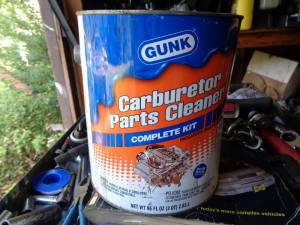 | 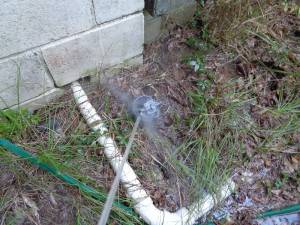 |
Carb Stand:
- You can put the carb in a vice to remove the screws, and for much of the following work.
Wrap in a shop towel; close the vice gently taking extra care with the choke and throttle linkages.
The vice is a needed extra pair of hands. - It can be very confusing trying to decide which way to bend the tang if it is not correct.
If the fuel level is low,Is the float high or low?, Do you need to bend the tang up or down? etc.
On the bench the carb is usually upside down, adding to the confusion. You should sort all this out before making an adjustments.
However, this setup works better than putting the carb (pre-CV) directly into the vice.
The carb is set upright as 'in use' making adjustments more straight forward.
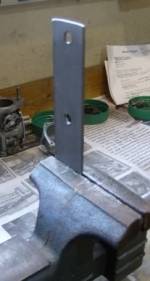 7)
7) 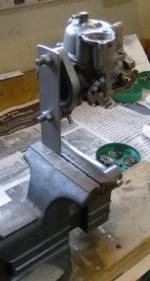 8)
8)
Servicing the Carb
See also Keihin Carb Upgrades - Butterfly and CV Types in the REF section of the Sportsterpedia.
You can purchase individual parts or a rebuild kit. The kits will not have needles, jets or the spring, washer & o-ring for the Idle Mixture Screw.
The rebuild kits are usually less than $20 and include:
- Carb-to-Manifold Seal
- Carb-to-Air Cleaner Gasket
- Float Bowl Gasket/O-ring
- New Float Needle
- New Accelerator Pump Diaphragm & Spring
- Some Misc Parts/Seals
Welch plug:
- Inspection:
- A close inspection around the walls of a welch plug can reveal possible leaks.
- Removal: 9)
- Whenever a welsh plug is removed, a new one should be installed in it's place, especially since a large part of the time, removal of one means destroying or deforming it.10)
- Drill an 1/8” hole thru it (just deep enough to break thru to the other side) off center and pry it out with a small punch. Be careful not to drill too deep which could destroy the nozzle assembly or casting. While prying it out, be careful not to damage the casting counter-bore edges around the plug.
- You can also drill a small hole in it and use a small tap just big enough to start in the hole. 11)
Thread the tap in the hole.
When it gets to the bottom of the passage, it will force the valve out with out damaging the bottom of carb passage.
Make sure to clean all the chips out to keep from plugging up passages later.
-
- The plug should be seated with a flat end punch that is slightly smaller than the diameter of the plug. The plug should be flat and not concaved to assure a tight fit. If leakage is suspected due to a rough or damaged welch plug seat in the casting, apply a small amount of epoxy or suitable sealant to the edges after installing it.
Links to Welch plug sites:
Remove the old filler material to expose the plug.
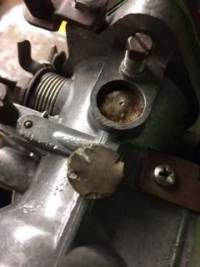 14)
14) 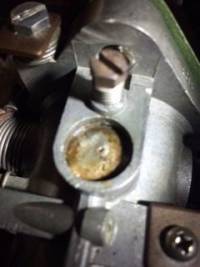 15)
15)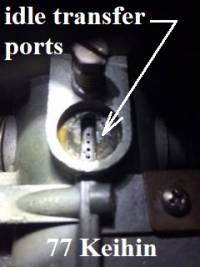 16)
16)
Check the plastic fuel inlet for cracks or breaks.
Time will make the plastic brittle. You can be proactive and just replace it with a brass 90 elbow.
See Replacing the Plastic Fuel Inlet Fitting with a Brass 90 Degree Fitting in the Keihin carb upgrade article in the REF section of the Sportsterpedia.
The brass replacement elbow part number (27371-76a).
The CVP brass elbow fits Harley CV40 carburetors 1988-2006 and Harley Keihin “butterfly” carburetors 1981-1989. 17)
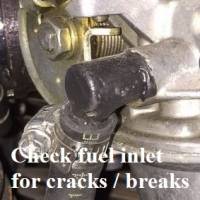
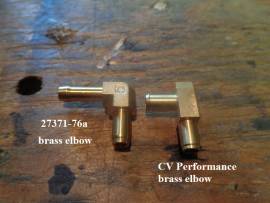
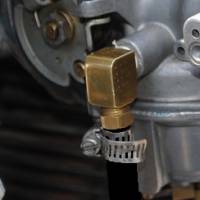
Or you can just break the plastic off the brass ferule with a pliers. 18)
Then file down the serrations underneath and plumb in some gas line to clamp straight onto it then connect to an elbow.
Flange Repair:
For a broken flange, you can try milling some slots in the flange and drill and tap the holes for screws.
You can use some JB Weld in there to insure a good seal.
Assembly
- Check float level:
- Use the specs in the FSM for setting the float level and check it every time you dismantle the carb (as the last thing before putting it back together).
- After checking the float level, then carefully put it back together.
- Replace the screws:
- It's best to replace the original Phillips screws for the bowl with stainless steel socket head screws.
Add'l Info & Pics -
Accelerator Nozzle, Check Valve, Float Seat - http://xlforum.net/forums/showthread.php?t=1624208
Accelerator Nozzle & Check Valve - http://xlforum.net/forums/showthread.php?t=1775068
High Altitude Modification Kit
- Carburetor modification kits (including jet(s) and an accelerator pump stop screw) were made available for 1200cc, 1340cc and 1000cc models to provide leaner fuel mixtures when operating at elevations above 4000 feet sea level. 25)
- Normally, leaner fuel/air mixtures are required for proper engine operation as the elevation above sea level increases. This high altitude kit (27096-79 for 1979 XLH (XL), XLCH, XLCR-1000) should be installed where there is evidence of a rich condition causing loss of smooth combustion, stumbling on acceleration or such other carburetor issues at high altitudes.
- The kit for Sportsters includes a #160 main jet, accelerator pump stop screw and the front down tube on the frame.
- Install and adjust the acc pump stop screw to extend 1/8“ past hole in lever.
- Note, any motorcycle modified for high altitude operation must be converted back to standard if operated at altitudes below 4000 feet. An overly lean condition can cause engine damage.
Float Valve
The 3-sided valve (left below) 'may' sit cock-eyed in the seat sometimes and cause a leak. 26) The four sided (right below) valve is 'supposed' to be an improved design.
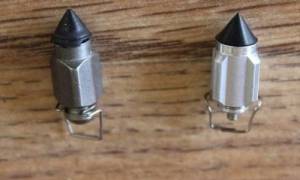 27)
27)
The float needle should just kiss the seat with no extra pressure. Aftermarket float valves have a spring loaded pin under the float tab. So when the valve tip closes onto the seat, you can still push the valve down further. The valve should 'just' close when measuring the float level. Pushing further in from there will not close the valve any further. But it will cause you to set the float level wrong. The valve should be a light seat when measuring. Some aftermarket float needles with the spring loaded pin also have a defective neoprene tip on the other end (which does not seal even when set right). 28) Since the tip on the needle on aftermarket ones don't work well, some would use the old original one (solid pin) to get a better measurement. 29) Beats assembling the carb only to have it sit there and flood with gas. Also make sure you have the float valve for the correct type of Keihin carb. The aftermarket valves are a little taller.
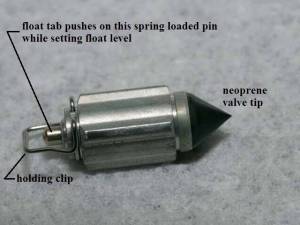 30)
30) 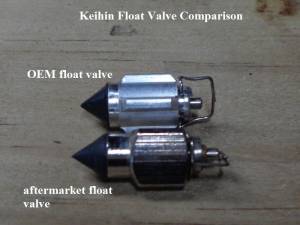 31)
31)
Float Level Adjustment.
The measurement in the FSM is a reference point that will keep the OEM float within a fully open and fully closed position.
Using aftermarket parts, you may have to adjust some.
With carb in bike, you can put a small catch tin under it and turn on the gas and move the float until the flow of gas actually stops.
(with no smoking or flames of course)
Procedure:
Two positions of the float valve must be set; The valve fully closed and The valve fully open.
Setting the closed position lower will tend to make the carb act lean at low speed.
Setting it higher can cause rich running, flooding and dribbles out the overflow line.
Equally important is to set the wide open float setting by bending the other metal tag on the float by the pivot.
This makes sure the float needle fully opens at full throttle openings and allows full fuel flow without starvation.
It also stops the float hitting the bottom of the float bowl and possibly getting damaged.
- Fully closed measurement: Tip the carb upside down so the float assembly is facing up.
Measure from outside surface of the float to flat mounting surface of the carb body casting.
Measurement: 9/16” to 5/8“ (14mm-16mm). - Fully open measurement: Next turn the carb over (right side up).
Measure from the same surfaces as above (outside surface of the float to flat mounting surface of the carb body casting).
Measurement: 1.10”-1.18“ (28mm-30mm).
The actual adjustments are made by carefully bending the two tabs of the metal clip on the float assembly until these two dimensions are achieved.
| Setting the float level. 32) | |
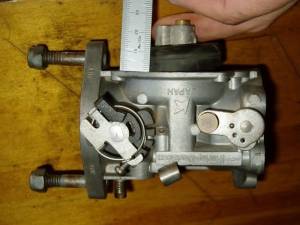 | 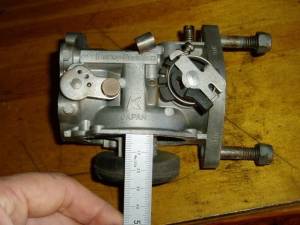 |

